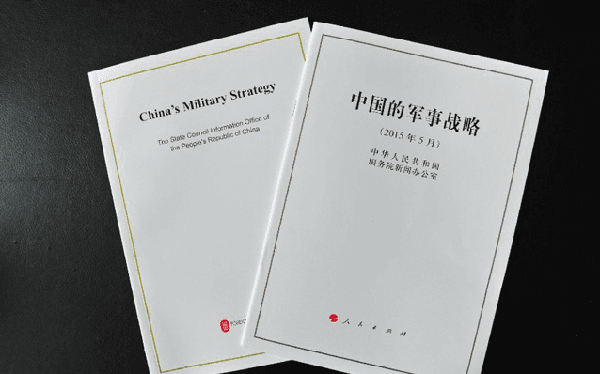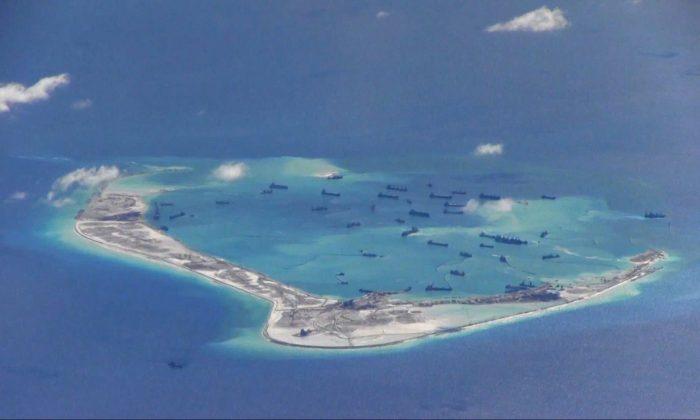The Chinese regime’s newly released military strategy masks its own ambitions of aggression and expansion, by accusing other nations of aggression and expansion.
The report is the first public Chinese Military Strategy white paper that outlines a new policy for “active defense,” according to the U.S. Naval Institute. It was released on May 26 by the Chinese Ministry of National Defense.
It begins with lofty language, declaring that to “realize the Chinese Dream of great national rejuvenation,” the Chinese people are looking to “join hands with the rest of the world to maintain peace, pursue development and share prosperity.”
Yet, like most historical policies to expand globally to realize national interests, there are all these other pesky countries standing in the way.
It states the Chinese regime “will unansweringly follow the path of peaceful development” through a policy “that is defensive in nature.” Yet at the same time the report was released, the Chinese regime repealed its strictly defensive policy, and told assets in the South China Sea to go on the offense.
In a statement that contradicts the overall tone of the report, it said the Chinese regime “will never seek hegemony or expansion.”

Soon after, it states “China has an arduous task to safeguard its national unification, territorial integrity and development interests.” It says that the Chinese regime is facing a “generally favorable external environment” that gives it an “important period of strategic opportunities for its development, a period in which much can be achieved.”
The report quickly jumps into growing conflicts with other nations. It says the U.S. rebalance to the Asia-Pacific region, and Japan’s revised military policies—both of which were in response to perceptions of the Chinese regime’s growing aggression—have “caused grave concerns among other countries in the region.”
The Chinese regime appears to be only quoting itself about these “grave concerns.” On the contrary, during the summit of the Association of Southeast Asian Nations (ASEAN) in April, countries including Vietnam, the Philippines, and Malaysia voiced their grave and serious concerns about the Chinese regime’s growing aggression.
The new strategy then turns the tables, saying that on issues “concerning China’s territorial sovereignty and maritime rights and interests,” some of the Chinese regime’s neighbors are taking “provocative actions and reinforce their military presence on China’s reefs and islands that they have illegally occupied.”
By stating this, the Chinese regime is trying to mask its land-grab in the South China Sea and East China Sea by accusing other nations of what it’s being accused of doing.
The Chinese regime is building islands in waters close to 1,300 miles from its mainland. It has been setting defensive perimeters around the man-made territory, and accusing other nations of “provocative actions” for challenging its own provocative actions.

It is using a classic form of legal warfare or “lawfare” for this statement. It creates its own laws to legalize its own actions and illegalize the actions of its adversaries. As was witnessed with the Chinese regime’s creation of an air defense zone over the East China Sea in November 2013, it is willing to just create new laws to declare the actions of others illegal.
The report then moves beyond the more distant conflicts, to those closer to the Chinese regime.
Contrary to its claims it “will never seek hegemony or expansion,” it states some of its largest problems are “‘Taiwan independence’ separatist forces,” as well as “separatist forces for ‘East Turkistan independence’ and ‘Tibet independence.’”
To vilify the groups opposed to the Chinese regime’s abuses, it takes a familiar method and mashes the identity of the ruling Party with that of China, thereby merging its identity with that of the Chinese people. It calls the groups opposed to the Chinese regime “anti-China forces.”
Taken as a whole, the Chinese regime’s new military strategy outlines its plans to continue suppressing dissidents, continue its push to take Taiwan, and continue its push into new territories in the South China Sea and East China Sea.
In a way, however, the Chinese regime’s military strategy is made clear: it’s built around strategic deception, the manipulation of its own laws to legitimize actions seen as illegal elsewhere, and around altering perceptions to validate its expansionist ambitions and to illegitimize the responses from other nations.


![[LIVE 4/26 at 10:30AM ET] New Push Started for Global Digital Currencies](/_next/image?url=https%3A%2F%2Fimg.theepochtimes.com%2Fassets%2Fuploads%2F2024%2F04%2F19%2Fid5633115-0426-1080x720.jpg&w=1200&q=75)


